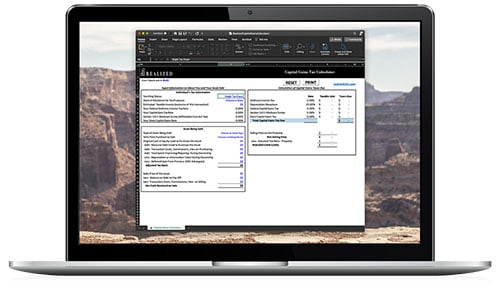
You can save a lot of time and effort at tax time by understanding the different types of income you’ll have to report on your Form 1040.
Most of us are quite familiar with income tax – we’ve had to pay it since our first jobs back in the day. Income tax is quite different from capital gains tax, though. Below we’ll highlight the differences between income and capital gains tax so you have a better understanding of how to report these income streams.
What is Income Tax?
The federal government and local and state jurisdictions impose a tax on money you earn by working. It’s an important source of revenue that’s used to fund crucial public programs and services, pay debt, law enforcement, national security, scientific and medical research, infrastructure development, Social Security, and many other areas that benefit U.S. citizens as a whole.
Income taxes in the U.S. are based on a “pay-as-you-earn” system where a portion of your regular earnings are withheld from your paychecks. This withholding amount provides governments with a steady stream of income throughout the year as well as helps taxpayers avoid having to come up with a large sum when it's time to file their tax returns.
Income taxes were first imposed in 1862 to provide financing for the Civil War. They were repealed after the war ended but reenacted in 1913, the same year the 1040 was first introduced to help taxpayers document their income and pay their tax obligations. The U.S. uses a progressive tax system – the more you earn, the higher your tax rate.
U.S. taxpayers’ federal tax brackets are determined by income and filing status. The following are income tax rates for 2022:
|
Tax Rate |
Single filer |
Head of Household |
Married filing jointly |
Married filing Separately |
|
10% |
$0 – $10275 |
$0 – $14,650 |
$0 – $20,550 |
$0 – $10,275 |
|
12% |
$10,276 – $41,775 |
$14,651 – $55,900 |
$20,551 – $83,550 |
$10,276 – $41,775 |
|
22% |
$41,776 – $89,075 |
$55,901 – $89,050 |
$83,551 – $178,150 |
$41,776 – $89,075 |
|
24% |
$89,076 – $170,050 |
$89,051 – $170,050 |
$178,151 – $340,100 |
$89,076 – $170,050 |
|
32% |
$170,051 – $215,950 |
$170,051 – $215,950 |
$340,101 – $431,900 |
$170,051 – $215,950 |
|
35% |
$215,951 – $539,900 |
$215,951 – $539,900 |
$431,901 – $647,850 |
$215,951 – $323,925 |
|
37% |
$539,901 or higher |
$539,901 or higher |
$647,851 or higher |
$323,926 – higher |
Corporations, partnerships, and independent contractors also pay income tax; amounts vary depending on the business structure. Individuals get a variety of tax exemptions and deductions that lower their tax liability.
What is Capital Gains Tax?
Capital gains are derived from profits on the sale of investment assets such as publicly traded stocks, bonds, gold or silver, cryptocurrencies, and real estate. Whenever you sell one of these investments for a higher price than you paid (your cost basis), you’ll have to pay capital gains tax on the profits.
That rate of capital gains tax depends on how long you held the asset. If it’s under one year, the profit is considered ordinary income and you’ll pay short-term capital gains tax according to your nominal tax rate as noted in the previous section above. If you held the asset for longer than 12 months, you’ll pay long-term capital gains tax according to your filing status and gross annual income.
The table below shows long-term capital gains tax rates for 2022.
|
Tax Rate |
Single filer |
Head of Household |
Married filing jointly |
Married filing Separately |
|
0% |
$0 – $41,675 |
$0 – $55,800 |
$0 – $83,350 |
$0 – $41,675 |
|
15% |
$41,676 – $459,750 |
$55,800 – $488,500 |
$83,350 – $517,200 |
$41,675 – $258,600 |
|
20% |
$459,751 and higher |
$488,500 and higher |
$517,200 and higher |
$258,600 and higher |
In order to determine your capital gains tax liability, you’ll have to determine your cost basis, which is what you paid for the divested asset. After recording any capital gains and losses on Form 8949, Sales and Other Dispositions of Capital Assets, you will report any capital gains or losses on Schedule D of your IRS Form 1040.
Putting it all Together
The main difference between income and capital gains taxes is that income tax is applied to money you earn, while capital gains tax is applied to money generated from the sale of investments or capital assets.
Income tax is determined by how much money you make and your filing status. Capital gains tax is determined by how long you held the asset. Short-term gains are considered ordinary income and are added to your gross income, so they can push you into a higher tax bracket. Long-term capital gains are taxed at 0, 15, or 20 percent depending on your gross income and filing status.
If you still have questions about either type of taxation or your potential income or capital gains tax liabilities, consider engaging the services of a certified tax professional.
This material is for general information and educational purposes only. Information is based on data gathered from what we believe are reliable sources. It is not guaranteed as to accuracy, does not purport to be complete and is not intended to be used as a primary basis for investment decisions. It should also not be construed as advice meeting the particular investment needs of any investor.
Realized does not provide tax or legal advice. This material is not a substitute for seeking the advice of a qualified professional for your individual situation.


